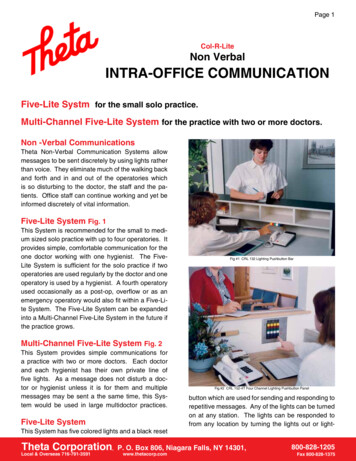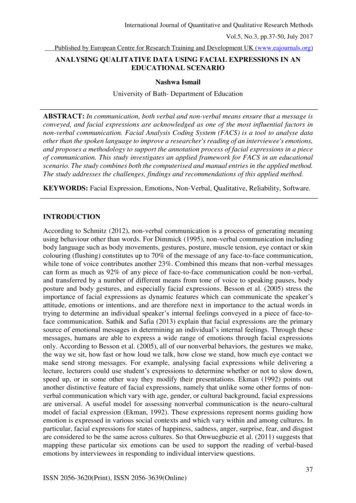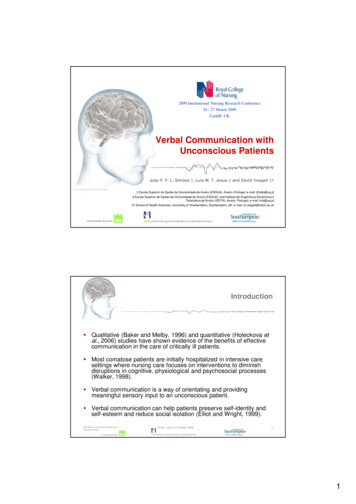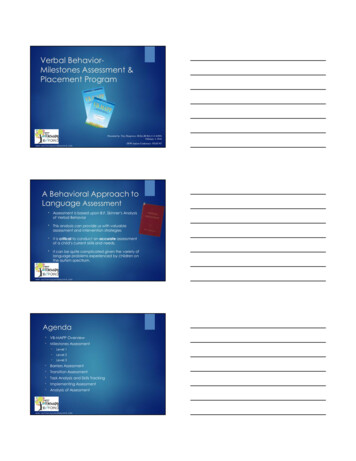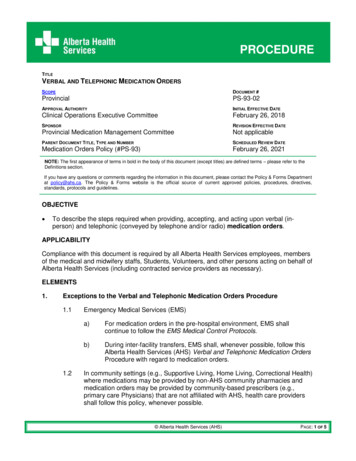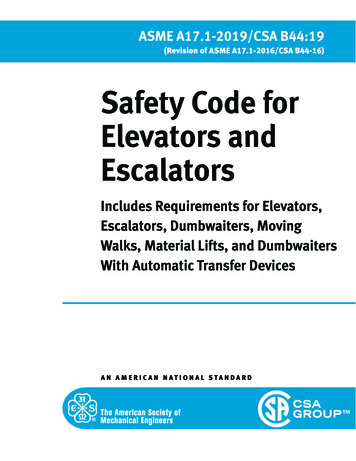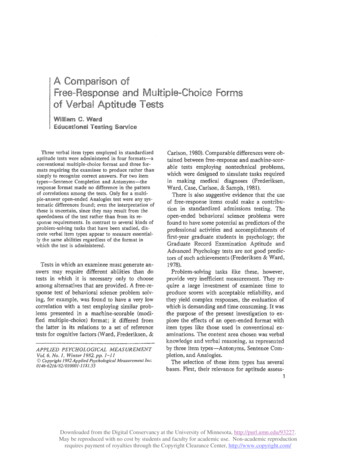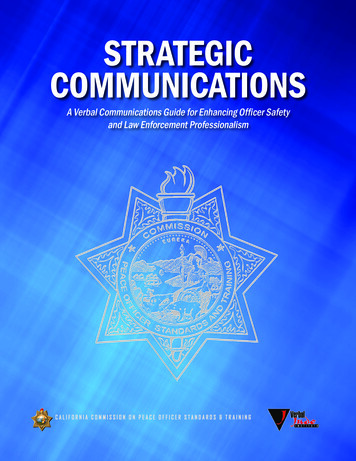
Transcription
STRATEGICCOMMUNICATIONSA Verbal Communications Guide for Enhancing Officer Safetyand Law Enforcement ProfessionalismCALIFORNIA COMMISSION ON PEACE OFFICER STANDARDS & TRAINING
ENHANCING LAW ENFORCEMENT PROFESSIONALISM THROUGHSTRATEGIC COMMUNICATIONSThe term “Strategic Communications,” as used by California POST, supports the conceptof infusing professional verbal techniques into law enforcement training components topromote officer safety, build trust within communities, enhance the concept of ProceduralJustice, and to promote the mission of POST to continually enhance the professionalismof California law enforcement in serving its communities. This document features verbalcommunication techniques, known as Tactical Communications, which were developed bythe late George Thompson, PhD and the Verbal Judo Institute. POST would like to thank theVerbal Judo Institute for their continued affiliation with POST since 1992 and for allowingPOST to use these copyrighted materials as approved by a mutually agreed to MOU.February 2019For further information on Strategic Communications, contact:POST Training Program Services BureauGreg Kyritsis, Sr. ConsultantGreg.Kyritsis@post.ca.gov 916-227-3909iiCALIFORNIA COMMISSION ON PEACE OFFICER STANDARDS AND TRAINING
TACTICAL COMMUNICATIONS DEFINEDTactical Communications (Tac Com) teaches officers how to stay calm and professionalunder verbal assault and how to generate voluntary compliance from even the most difficultpeople. Tac Com also teaches officers how to identify when their words have failed and howto then transition, through tactics, into approved force options when necessary. The ability tocommunicate effectively is an officer’s greatest asset. These tactics enhance officer safety andcan promote public trust and confidence in law enforcement.SPECIAL ACKNOWLEDGEMENTThe creator and founder of TacticalCommunications, also known asVerbal Judo, was George Thompson,Ph.D., a retired university professor,martial artist, police officer, and anexpert in situational rhetoric: howlanguage affects people in crisis. Dr.Thompson also founded the VerbalJudo Institute, Inc.These communication tacticspresented by the Verbal Judo Instituteare also federally copyrighted andtrademark protected. POST is thankfulto the Institute for allowing CaliforniaPOST the use of these trainingmaterials to enhance the verbalcommunication skills of our POSTaffiliated law enforcement agenciesand their staff.Since the establishment of the Verbal Judo Institute, in 1982, Dr. GeorgeThompson and staff have taught the concept of Tactical Communications toover one million students in the United States, Canada, Australia, South Africa,and in a number of countries in Europe. Approximately half of these studentswere peace officers.George Thompson died of Cancer on June 7, 2011; however, the VerbalJudo Institute continues to offer this valuable training through a team ofexperienced professionals in honor of continuing his legacy.Refer to www.verbaljudo.com for any further information on this trainingprogram.ENHANCING LAW ENFORCEMENT PROFESSIONALISM THROUGH STRATEGIC COMMUNICATIONSiii
ivCALIFORNIA COMMISSION ON PEACE OFFICER STANDARDS AND TRAINING
TACTICAL COMMUNICATIONSTABLE OF CONTENTSI.Enhancing Agency Culture through Strategic Communications – POST Perspective . 1II.Re-Introducing the Training in Tactical Communications Under the POST Umbrella ofStrategic Communications . 2III.Law Enforcement and the Use of Communication Skills. 4IV.The Goals of Tactical Communications . 5V.Enhancing the Four Tenets of Procedural Justice through the Five Universal Truths ofTactical Communications . 5VI.The Profession of Law Enforcement and Public Expectations . 6VII.The Goal of Law Enforcement – Gaining Compliance . 6VIII.Moving Beyond Words When Words Fail – S.A.F.E.R. . 7IX.Core Communication Concepts – The Contact Professional. 8X.The Three Great Arts – Representation, Translation & Mediation. 12XI.Understanding Verbal Abuse and The Principle of Disinterest. 13XII.The Three Main Types of People We Deal With. 15XIII.How to Handle Verbal Abuse – Deflection and Redirection. 15XIV.The Five Tools to Generate Voluntary Compliance – L.E.A.P.S. . 17XV.Paraphrase – The Most Powerful Communication Tool. 18XVI. Proxemics – Spatial Relations . 19XVII. The Tactical 8-Step Vehicle Stop and Pedestrian Approach . 21XVIII. The Tactical 5-Step for Uncooperative Subjects . 23XIX. How to Diagnose a Verbal Encounter – P.A.C.E. 25XX.The Importance of How You Communicate Your Message. 26XXI.Commentary - Tactical Communications and Career Survival . 27ENHANCING LAW ENFORCEMENT PROFESSIONALISM THROUGH STRATEGIC COMMUNICATIONSv
viCALIFORNIA COMMISSION ON PEACE OFFICER STANDARDS AND TRAINING
I.ENHANCING AGENCY CULTURE THROUGH STRATEGIC COMMUNICATIONTECHNIQUES – A POST PERSPECTIVEA. Culture is defined in a number of ways, and influenced by things like history,environment, and even expectations.1. Merriam-Webster defines culture as “the set of shared attitudes, values, goals, andpractices that characterizes an organization or institution.”2. Using the above definition, this can certainly apply to the law enforcementprofession and more specifically to the culture of one’s own organization oragency.B. When identifying best practices of agency culture among law enforcementorganizations, a key assessment component is how an agency’s reputation is viewedby its local community. A trait that can enhance an agency’s image, when interactingwith the public is treating all people by the Golden Rule; treating others like youwould like to be treated in identical situations and with dignity and respect.1. The Golden Rule can be seen as a “basic common sense” communication tooland should be considered a guiding factor in law enforcement’s dealings withthe public and it certainly should be a consideration when dealing with fellowemployees within one’s organization.2. Having a genuine respect for all people that law enforcement deals with doesn’tdemand we have respect for known child molesters, sex traffickers, drug dealers,violent gang members or those who beat their children and wives. But as lawenforcement officers, there is an expectation we treat them with dignity andrespect, as guided by the Golden Rule; “trying to empathize with the other byputting ourselves in their shoes or in their situation.”3. Our profession is in the Customer Service Industry, and every one of ourcustomers’ experience is based on the encounters they have with our employees.The perceived experience our customers’ encounter from our employeesultimately defines the reputation and culture of the agency.4. Some encounters we can control and some we cannot. The daily encountersby law enforcement touch all kinds of people from all walks of life, includingdifferent ethnicities, ages, sexual orientation, religions, and those cooperativeand uncooperative, which can make the job challenging at times. There is alsoa learning curve to achieving a mastery in one’s verbal communications withdifferent types of people, especially with those who can be confrontational andargumentative, which can take years to achieve.C. When evaluating law enforcement training, both in basic training and in-servicetraining, we find that officers receive very minimal hours of training in professionalverbal communications. It is estimated that peace officers spend more than 90%of their time verbally interacting with people; all types of people, with all types ofENHANCING LAW ENFORCEMENT PROFESSIONALISM THROUGH STRATEGIC COMMUNICATIONS1
attitudes and moods. Being able to apply the Golden Rule to various attitudes andmoods of people that officers encounter daily takes significant training. A majorverbal communications trait that can enhance an officer’s success is the ability togenerate voluntary compliance from all types of people. This training should alsoinclude the use of Appropriate Presence and Words as an officer’s initial force option.As noted by Dr. Thompson’s training, when officers show up at the scene, theyneed to realize that “it is showtime” and they need to put on the “right face” for thesituation they are responding to; “putting on that face” that portrays to others thatyou “really care” and are there to truly help.D. Mastering the trait of the Golden Rule through Professional Verbal Communicationsrequires additional commitment in training and focus, but once an agency commitsto making it part of its culture it can truly make a major difference in promotingpublic trust and confidence in their local communities. Additionally, law enforcementpersonnel will also find that once they master this trait, it also tends to enhanceofficer safety and overall officer morale.II.RE-INTRODUCING TACTICAL COMMUNICATIONS UNDER THE POST UMBRELLA OFSTRATEGIC COMMUNICATIONSA. As previously defined in the opening (page ii), the term “Strategic Communications”supports the concept of infusing professional verbal communication techniquesinto various law enforcement training components to promote officer safety andbuild trust within our communities. In the upcoming years, POST will continue toreview verbal communication techniques that can enhance the profession of lawenforcement. POST realizes these various techniques may also be copyrightedby its creators and, if deemed worthy, POST will attempt to develop interagencyagreements to use these techniques in future POST programs. This has been donewith the Verbal Judo Institute and their training in Tactical Communications in thisdocument.B. As noted, the verbal communication techniques featured in this training guide areTactical Communications, also known as Verbal Judo, which was developed by thelate George Thompson, PhD and the Verbal Judo Institute in 1982. As a historicalreference, thousands of California law enforcement police officers and deputysheriffs were personally trained by Dr. Thompson between 1989 through 1993.Dr. Thompson was personally contracted by the individual agencies to conductthis training. The trained agencies included small, medium and large organizationsincluding: Long Beach Police, Los Angeles Police, Los Angeles County Sheriff, SantaAna Police, Garden Grove Police, San Diego Police, San Bernardino County Sheriff,Kern County Sheriff, Merced Police, Sacramento Police, West Sacramento Police, andmany others.C. These verbal training techniques support the concept of the Golden Rule and werefirst introduced to POST in 1992. POST then committed to an agreement with Dr.Thompson to develop a POST training video production on Verbal Judo that was2CALIFORNIA COMMISSION ON PEACE OFFICER STANDARDS AND TRAINING
circulated statewide to all POST affiliated agencies in 1993. A follow-up productionwas released again in 2000. The last updated two-hour POST DVD productionwas released statewide in 2007, which included 14 scenarios demonstrating theuse of the Tactical Communication in a variety of situations. The scenarios in thispresentation included: vehicle stops, pedestrian stops, domestic violence, landlordtenant dispute, court testimony, dealing with subjects under the influence, and anumber of other situations. The production also included a detailed guide of allthe tactics and scenarios used in the DVD. POST also contracted with Dr. Thompsonat that time to present eight instructor courses that resulted in approximately 250new instructors being certified to return to their basic academies and their homeagencies to continue the training in Tactical Communications.D. Over the past several years, the training in Tactical Communications in Californiahas somewhat eroded from the original commitment made by the Californialaw enforcement agencies and POST. Much of this lack in reinforcement trainingwas due to retirements of chief executives and lead trainers of the departments.Unfortunately, this is not uncommon and historically it occurs not only in the lawenforcement profession but in many other professions.E. Upon POST’s further review of Tactical Communications, it has determined that theseverbal communication techniques are still relevant and very much applicable totoday’s law enforcement profession. These techniques continue to demonstrate thatthey enhance officer safety and positive interactions with the public, especially ingenerating voluntary compliance and de-escalating difficult encounters that officersregularly face. Many of these techniques also enhance the tenets of ProceduralJustice.F. POST has recontacted the Verbal Judo Institute and has discovered that theirInstitute is still in full operation and is serviced by a cadre of skilled trainers, mostwith extensive law enforcement training backgrounds, that have and continue todeliver this training throughout the United States, Canada, Australia, South Africaand to various countries in Europe. More than one million students have receivedtraining in Tactical Communications, a.k.a. Verbal Judo. Based on the continuedeffectiveness of this program, POST has once again committed to an agreement withthe Verbal Judo Institute for the development of an additional DVD production andan update of this training guide in Verbal Communications. The Verbal Judo Institutecan be referenced at www.verbaljudo.com for further information.G. The techniques featured in this document are not meant to be listed in a specificsequence, but are listed as techniques that can be incorporated into a variety of lawenforcement training settings. Past practices have shown that introducing thesetechniques in the early components of a basic law enforcement academy work best,along with weaving and reinforcing these concepts throughout the remaining basictraining program. They should then be woven into the FTO (Field Training Officer)Program and then into other ongoing in-service training, especially in the area of deescalation and force options.ENHANCING LAW ENFORCEMENT PROFESSIONALISM THROUGH STRATEGIC COMMUNICATIONS3
H. As you review the techniques below on Tactical Communications, you will realizehow these tactics also enhance the concepts of Procedural Justice, which furtherenhances community trust and the professional image of the law enforcementprofession. As it has been noted by some trainers, “Procedural Justice is theultimate concept we are trying to achieve, and Tactical Communications is the lawenforcement tool, the ‘how to’ for achieving this concept.”THE FOLLOWING SEGMENTS AND CONCEPTS ARE FEDERALLY COPYRIGHTED ANDTRADEMARK PROTECTED BY THE VERBAL JUDO INSTITUTE AND ARE NOTED BY THISSPECIFIC ICON ----III.LAW ENFORCEMENT AND THE USE OF PROFESSIONAL COMMUNICATION SKILLSA. Law enforcement personnel are often faced with situations that can result in seriousinjury or loss of life. Officers will periodically be confronted by individuals whobecome very challenging and argumentative because they are either under theinfluence of a substance (alcohol or narcotics), suffering from mental impairment,or under the influence of anger or rage based on their personal circumstances.Basic interpersonal skills do not usually work in situations like this. It has been said,“Common sense, is most uncommon under pressure.”B. Just as officers are trained in the use of tactics to deal with combative andlife-threatening situations, officers also need to learn skillful tactics in verbalcommunication to attempt to diffuse difficult verbal encounters, when possible, thatmay escalate and jeopardize an officer’s safety or the safety of others.C. The techniques developed by Dr. George Thompson for the Verbal Judo Institute,initiated in 1982, have proven to be very effective, when applied correctly, in dealingwith people, especially with argumentative and uncooperative subjects. Thesetechniques are still very applicable today in our law enforcement environment;probably more so today than ever before.D. These same verbal techniques should not just be limited to law enforcementsituations; most of these tactics can and should be used internally within lawenforcement organizations amongst peers, supervisors, managers and executives intheir daily interactions with each other.E. Additionally, many of the techniques defined in Tactical Communications can also beused within an officer’s interactions within their own family and their own personalsocial settings.F. As our law enforcement profession understands, officers experiencing and viewingtragic incidents continually in their careers may become jaded, especially ifthey don’t balance their lives with their families and their social and communitycommitments. Tac Com has also been known to be effective in promoting“emotional and career survival,” not only for the officers, but for their own familymembers as well.4CALIFORNIA COMMISSION ON PEACE OFFICER STANDARDS AND TRAINING
G. And finally, some officers perceive that Tactical Communications is just about beingnice to people. Tactical Communications isn’t just about being nice to people, it’sabout being professional.IV.THE GOALS OF TACTICAL COMMUNICATIONS (Tac Com)A. Enhances Officer Safety1. Helps officers decrease work-related injuriesB. Enhances Professionalism1. Increase in professionalism helps officers to:a. Generate voluntary complianceb. Enhance trust in the communityc. Decrease citizen complaintsd. Decrease vicarious liabilitye. Enhance court testimony skillsf.Lessen personal stress on the Jobg. Increase officer moraleh. Lessen personal stress within one’s own familyi.V.Enhance career and emotional survivalENHANCING THE FOUR TENETS OF PROCEDURAL JUSTICE THROUGH THE FIVEUNIVERSAL TRUTHSA. The Five Universal Truths of Tactical Communications were established by Dr. GeorgeThompson for the Verbal Judo Institute and they are the foundation for their verbalcommunication training techniques. The Five Universal Truths:1.All cultures want to be treated with dignity and respect.2.All people would rather be asked than told what to do.3.All people want to know why they are asked or told to do something.4.All people would rather have options than threats.5. All people want a second chance to make matter better.B. As noted by the President’s Task Force Report on 21st Century Policing, that is furtherreferenced by the U.S. Department of Justice, Office of Community Oriented PolicingServices (COPS) and its affiliation with the National Initiative for Building CommunityTrust and Justice, the term Procedural Justice is a concept that is vital to lawenforcement’s role in developing trust within their communities. Procedural Justicedefined:1. Procedural Justice focuses on the way police and other legal authorities interactwith the public and how the characteristics of those interactions shape theENHANCING LAW ENFORCEMENT PROFESSIONALISM THROUGH STRATEGIC COMMUNICATIONS5
public’s views of the police, their willingness to obey the law, cooperation withthe police in fighting crime, and actual crime rates. (COPS/US DOJ Office/Trust &Justice Briefs)2. Procedural Justice is based on Four Central Tenets (COPS/US DOJ)a. VOICE - Giving citizens a voice during encountersb. RESPECT - Treating people with dignity and respectc. NEUTRALITY - Being neutral in decision makingd. TRUSTWORTHINESS – Promoting behavior and actions that conveytrustworthinessC. The verbal techniques of Tactical Communications, which are based on the FiveUniversal Truths, also promote the Four Tenets of Procedural Justice, which ultimatelyenhances the community trust and cooperation that all law enforcement agenciesseek.VI.THE PROFESSION OF LAW ENFORCEMENT – Public ExpectationsA. High Visibility1. We speak in a fishbowl; never again can you use words to express your personalfeelings. When you are known as a peace officer, or as a public service employee,you lose the right of free speech in public, both on- and in many occasions offduty.B. Ethical Standards of Conduct – “You Must Live What You Represent”1. There is an expectation by the public and the courts that you must live to thestandard you enforce.C. The Badge represents a Symbol of Public Trust1. With that trust, we gain power and responsibility to perform the various duties ofa peace officer.VII. THE GOAL OF LAW ENFORCEMENT – Gaining ComplianceA. The goal of law enforcement is to gain compliance.1. The best kind of compliance is voluntary compliance.B. Studies have shown that verbal communication is the most important component ofan officer’s duty.1. More than 95% of policing is verbal interaction with people.2. Officers with good verbal communication skills are usually more successful ingaining voluntary compliance.6CALIFORNIA COMMISSION ON PEACE OFFICER STANDARDS AND TRAINING
C. When words fail, many times force options must be initiated to gain compliance withuncooperative suspects.1. Force Options may vary among law enforcement agencies.2. Options will usually involve professional presence up to lethal force.a. Professional verbal skills should be used throughout the use of force options(escalation and de-escalation) as much as possible, while at the same timemaintaining officer safety.3. It should be noted that anytime an officer uses physical force to enforce an arrest,especially with an uncooperative and resisting suspect, it can visually look bador disturbing to those witnessing the incident. Officers need to understand thisand to do their best to “paint a picture” to those witnessing the incident that thesuspect is the “bad guy,” not the officer.a. This can usually be done effectively with the use of proper language andinstructions given to the suspect; as long as officer safety is not jeopardized.b. Making derogatory comments toward the suspect will usually make theofficer appear unprofessional and out of control and his comments andactions will usually be challenged in court.c. Learning to use effective and professional verbal skills during a physical forceencounter can gain the officer empathy from those watching, especiallyin today’s environment when most people have a mobile phone that canimmediately record an event, both in audio and video.d. The use of effective verbal skills under stress can be very challenging andofficers need to be exposed to these type of training situations regularlyin order to achieve a level of competency to function under such stressfulsituations.VIII. MOVING BEYOND WORDS – USING THE ACRONYM S.A.F.E.R.A. Officers realize that good verbal skills are essential to gaining voluntary compliance,but officers also know that “words don’t always work.”B. Officers must be prepared at any moment to take appropriate action, sometimesimmediate action, to adapt to situations when subjects become uncooperative andcould jeopardize the safety of the officer(s) or others.C. Officers should also be prepared to articulate the reason that triggered their actionsand be able to articulate their specific use of force options and verbal techniquesthey used in their suspect interaction. This articulation is usually made to theirsupervisors and noted in their written police reports.D. S.A.F.E.R. - The five conditions when officers must take appropriate action:1. SECURITYa. Whenever others are in imminent jeopardy - ACT!b. Whenever property under your control is threatened – ACT!ENHANCING LAW ENFORCEMENT PROFESSIONALISM THROUGH STRATEGIC COMMUNICATIONS7
2. ATTACKa. Whenever your personal danger zone is violated - ACT!b. Or the safety of another is threatened – ACT!3. FLIGHTa. Whenever a subject unlawfully flees your presence - ACT!b. Based on your training and situation.4. EXCESSIVE REPETITIONa. No voluntary compliance is forthcoming.b. You have exhausted all verbal options - ACT!5. REVISED PRIORITIESa. Whenever a matter of a higher priority requires your immediate attention orpresence - ACT!IX.CORE COMMUNICATION CONCEPTS – The Contact ProfessionalA. When dealing with others in the line of duty, officers must remember that they areContact Professionals, which means that they represent more than themselves. Aspolice officers, they also represent the police chief or sheriff, the department, thecity council (or direct governing body, i.e., county supervisors), the State, the UnitedStates Constitution, Bill of Rights and, most of all, the people.B. Those professionals who must interact with people daily need to understand basic orcore communication concepts to be more effective in their interpersonal skills. Thesecore communications can potentially defuse volatile situations and acts of violencethat law enforcement encounters regularly.C. The below listed core communication concepts should not only be used by lineofficers, but should also be referenced by all staff members, especially supervisors,managers, and executive staff. These core concepts truly enhance professionalcommunications and assist in maintaining a positive work environment; theycan also promote a positive morale among employees. As stated earlier, thesetechniques can also be modified by employees for use with their own familymembers to further enhance their home environment.D. Core Communication Concepts:1. What is the opposite of talking? It should be listening, but for most people itis waiting. Waiting to interrupt.a. This is a typical action of most people who are not trained in professionalcommunication skills.2. The Four Steps to Active Listening:a. Open/Unbiased is the principle of being disinterested – not biased. Your mindshould not already be made up as to what has occurred.8CALIFORNIA COMMISSION ON PEACE OFFICER STANDARDS AND TRAINING
b. Hearing What is said – Literally being in a position away from noise or otherdistractions.1) It is also important to project that you are listening – projecting that“listening face” (eye-to-eye contact).2) When projecting that “listening face” be careful to never project a facialexpression of rolling your eyes back in response to a comment made bythe sender. This is disrespectful and, in some cases, can be a cause forescalating anger and rage in the other person that could also result in aphysical altercation.c. Interpretation - Determining if what they say is in concert with what is takingplace. If not, what does it mean? Use of paraphrasing can further assist inclarifying the other’s message.d. Act appropriately - decoding the message in what is said and responding inan appropriate manner.Example – Statement by a victim of a burglary:1) “Where the hell have you been? I called when I got home almost an hour ago.I’ve been robbed.”2) DECODED - “I came home and found my house broken into and I’m upset andneed some help.”3. Learn not to react to words, but react to needs.a. Remember that the more a person is upset or angry, the more disjointed andoffensive their words are going to be.b. Try and understand, or decode, why they are angry and frustrated andidentify the actual problem causing the behavior.c. You will be surprised how well this also works at home with your own familymembers.4. Use of Tactical Empathya. To see the situation through the eyes of the other for the purpose ofobtaining and maintaining the tactical advantage of the situation.5. Understanding the Three Street Truths:a. Many times, when under pressure, “People Never Say What They Truly Mean”1) Many times, subject’s words are expressing or venting due to what hadjust occurred to them, which can cause a) Rageb) Angerc) FrustrationENHANCING LAW ENFORCEMENT PROFESSIONALISM THROUGH STRATEGIC COMMUNICATIONS9
b. Understanding that Two People (officer and subject) actually equals Six Peoplewith varying opinions and perceptions. As noted:1) Real Self vs. Real Selfa) The actual true self, which may not be truly understood by the self onhow they truly come across to others.2) Self as seen by Self vs. Self as seen by Selfa) The perception of one’s self as they believe they are perceived.3) Self as seen by Other vs. Self as seen by Othera) The perception of the self as they believe the other perceives them.6. Verbal delivery style makes up 93% of one’s communication, and studiesreflect that one’s message is made up of three actual components:a. Content: 7-10%b. Voice: 33-40%c. Other Non-Verbals: 50-60%1) Voice and other non-verbals make up the most percentage of yourmessage.2) Understand that if your voice and other non-verbals are inappropriateor unprofessional your message will not be received well and couldnegatively complicate a situation.d. The below pie chart reflects the three components of verbal delivery:CONTENT7%VOICE33%OTHERNONVERBALS60%7. Additional review of the components to a message a. Content - This is the literal message that is sent. This is almost meaninglesswithout the o
with the Verbal Judo Institute and their training in Tactical Communications in this document. B. As noted, the verbal communication techniques featured in this training guide are Tactical Communications, also known as Verbal Judo, which was developed by the late George Thompson, P

